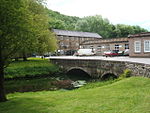Ashford Black Marble
Collections of Derby Museum and Art GalleryGeology of DerbyshireLimestone formations of the United KingdomRock formations of EnglandUse British English from August 2015

Ashford Black Marble is the name given to a dark limestone, quarried from mines near Ashford-in-the-Water, in Derbyshire, England. Once cut, turned and polished, its shiny black surface is highly decorative. Ashford Black Marble is a very fine-grained sedimentary rock, and is not a true marble in the geological sense. It can be cut and inlaid with other decorative stones and minerals, using a technique known as pietra dura.
Excerpt from the Wikipedia article Ashford Black Marble (License: CC BY-SA 3.0, Authors, Images).Ashford Black Marble
Mount Pleasant, Derbyshire Dales
Geographical coordinates (GPS) Address Nearby Places Show on map
Geographical coordinates (GPS)
| Latitude | Longitude |
|---|---|
| N 53.22 ° | E -1.71 ° |
Address
Mount Pleasant
DE45 1QE Derbyshire Dales
England, United Kingdom
Open on Google Maps










